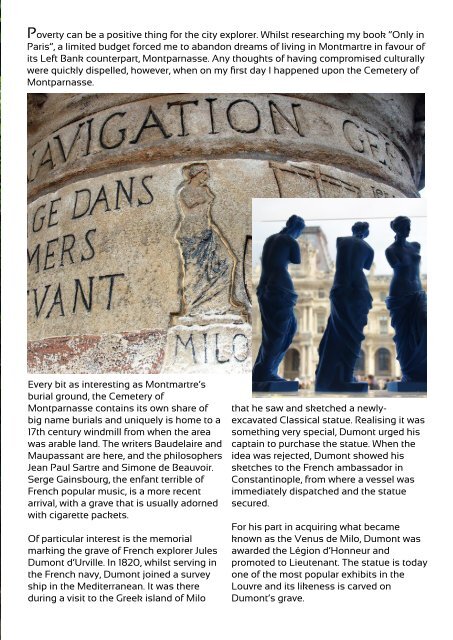Issue No. 12
Sensational cities to tiny villages, food and wine, culture and heritage. Champagne, an aristocratic saffron grower, Anger, Montparnasse, Morzeine, Carol Drinkwater shares her passion for France. Gorgeous photos and fabulous features will transport you to the heart of France in this brilliant, free magazine...
Sensational cities to tiny villages, food and wine, culture and heritage. Champagne, an aristocratic saffron grower, Anger, Montparnasse, Morzeine, Carol Drinkwater shares her passion for France. Gorgeous photos and fabulous features will transport you to the heart of France in this brilliant, free magazine...
- No tags were found...
You also want an ePaper? Increase the reach of your titles
YUMPU automatically turns print PDFs into web optimized ePapers that Google loves.
Poverty can be a positive thing for the city explorer. Whilst researching my book “Only in<br />
Paris”, a limited budget forced me to abandon dreams of living in Montmartre in favour of<br />
its Left Bank counterpart, Montparnasse. Any thoughts of having compromised culturally<br />
were quickly dispelled, however, when on my first day I happened upon the Cemetery of<br />
Montparnasse.<br />
Every bit as interesting as Montmartre’s<br />
burial ground, the Cemetery of<br />
Montparnasse contains its own share of<br />
big name burials and uniquely is home to a<br />
17th century windmill from when the area<br />
was arable land. The writers Baudelaire and<br />
Maupassant are here, and the philosophers<br />
Jean Paul Sartre and Simone de Beauvoir.<br />
Serge Gainsbourg, the enfant terrible of<br />
French popular music, is a more recent<br />
arrival, with a grave that is usually adorned<br />
with cigarette packets.<br />
Of particular interest is the memorial<br />
marking the grave of French explorer Jules<br />
Dumont d’Urville. In 1820, whilst serving in<br />
the French navy, Dumont joined a survey<br />
ship in the Mediterranean. It was there<br />
during a visit to the Greek island of Milo<br />
that he saw and sketched a newlyexcavated<br />
Classical statue. Realising it was<br />
something very special, Dumont urged his<br />
captain to purchase the statue. When the<br />
idea was rejected, Dumont showed his<br />
sketches to the French ambassador in<br />
Constantinople, from where a vessel was<br />
immediately dispatched and the statue<br />
secured.<br />
For his part in acquiring what became<br />
known as the Venus de Milo, Dumont was<br />
awarded the Légion d’Honneur and<br />
promoted to Lieutenant. The statue is today<br />
one of the most popular exhibits in the<br />
Louvre and its likeness is carved on<br />
Dumont’s grave.

















